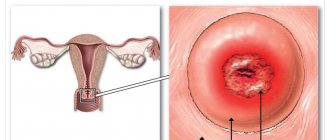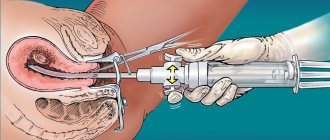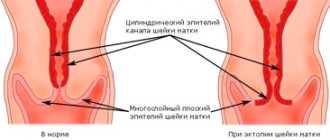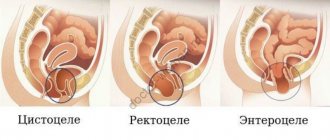Cervical erosion (correct name ectropion) is an inflammatory disease associated with changes in the properties of organ tissue. Erosion is most often asymptomatic and detected in late stages, which complicates the process of treating the disease. This disease, without proper treatment, leads to malignancy of soft tissues and the appearance of cervical cancer.
APPOINTMENT WITH A GYNECOLOGIST - 1000 rubles. CONSULTATION ON THE RESULTS OF ANALYSIS OR ULTRASOUND — 500 rubles.
CLICK TO SIGN UP
Causes of cervical erosion
The content of the article
There are many causes of the disease:
- Hormonal imbalance
- any hormonal imbalance is a favorable factor for the development of erosion, in particular this is especially evident during puberty, pregnancy and menopausal changes. - Reduced immunity. The body cannot resist infections.
- Injury to the cervix
- can occur during operations, difficult childbirth, accompanied by ruptures and various interventions, during abortions and diagnostic curettages, during sexual intercourse. - Inflammatory diseases of the vagina
(bacterial vaginosis, thrush, vaginitis, colpitis). - Viral and bacterial diseases
- viruses and infections, in particular sexually transmitted ones, provoke the development of inflammatory processes and erosions (ureaplasmosis and mycoplasmosis, trichomoniasis, urogenital chlamydia, genital herpes, herpes virus type 2, human papillomavirus). - Early sexual life and childbirth
- the age of greatest risk is considered to be the period from 15 to 17 years (the vaginal mucosa reaches full development only by 20-22 years). - Congenital pathology
(pseudoerosion, ectopia)
, hereditary predisposition
- doctors note that in patients who have close relatives suffering from the disease, the risk of developing pathology increases.
Contraindications
It is necessary to ensure that there are no contraindications before cauterizing the erosion, for which the woman is prescribed a whole range of studies. The main restrictions are:
- blood clotting disorders;
- malignant degeneration of tissues of the eroded area;
- sexually transmitted diseases (in acute or chronic stages);
- inflammatory processes in the genitourinary system;
- manifestation of signs of bleeding;
- pregnancy, less often - breastfeeding;
- early period after childbirth, the presence of lochia;
- installed IUD;
- history of caesarean section;
- diabetes;
- HPV carriage;
- exacerbation of any chronic disease.
Not all methods of cauterization of cervical erosion are universal; if the damage to the epithelial area is significant, only a few methods are suitable.
If the principles of contraindications are not followed, various complications may occur after the procedure. That is why at the stage of early examination it is necessary to take blood tests (biochemical and general), urine, smears, cytology and others to determine the woman’s hormonal status and the absence of bacterial and viral inflammation.
Types and classification
There are two forms of the disease: pseudo-erosion, true erosion.
True cervical erosion
. The diagnosis is made when there are changes visible to the eye on the soft tissues of the cervix. During an examination using mirrors, a gynecologist can see a bright red spot with clearly defined boundaries. The defect is located around the external os of the uterus. The diameter of the altered tissue can reach 1 cm. The disease remains in this stage for up to 2 weeks, after which the transition to the ectopic stage occurs.
Pseudo-erosion (ectopia)
. Most often it appears as a consequence of congenital pathologies of the development and structure of the mucosa. Also, the cause of ectopia can be a previous true erosion. With this form of the disease, an area of abnormal excessive tissue growth appears at the entrance to the cervix. Healthy tissue of the cervical mucosa is replaced by cylindrical epithelial cells, which are located in the cervical canal. With this diagnosis, there are usually no mechanical damage to the mucosa and ulcers. It occurs mainly in young women of reproductive age and women with high levels of estrogen in the blood. Unlike true erosion, the congenital form of the disease does not require special treatment.
Why is colposcopy necessary?
A definitive diagnosis of erosion can only be made with colposcopy. After treating the cervical surface with Lugol's solution, all existing defects become noticeable:
- With true erosion, a bright red area of desquamated epithelium is detected, on the surface of which the vessels are clearly visible.
- With pseudo-erosion, an area of replacement of healthy multilayered squamous epithelium with areas containing pathological glands, cysts, and unusual cells is visible.
- With ectropion, an inversion of the tissues of the cervical canal into the vagina is detected. The affected neck has a bright red eroded surface. Scar tissue changes are often observed.
For final diagnosis, a cytology smear is taken to find out what cells the modified area consists of. If a gynecologist discovers cancer cells, the disease moves from the category of erosions to oncological ones. This is why erosion is dangerous - without treatment it can increase, become infected and transform into uterine cancer.
Basic forms of pseudo-erosion
- Congenital
– caused by genetic predisposition. It can be diagnosed already at the first appointment with a gynecologist. Only this form of erosion is capable of independent and spontaneous disappearance. All other types of erosion require treatment. - Acquired
- appears after puberty, does not depend on genetics. - Uncomplicated
– symptoms of the disease are completely absent. The disease does not progress. - Complicated
– foci of inflammation occur. There is a high risk of tumors (cancer). Recurrent stage.
Pseudo-erosion is classified:
- Due to their origin, there are dishormonal, post-traumatic (for example, after childbirth or abortion) and congenital.
- According to the dynamics of development - they determine the healing, stationary (stable) or progressive stages - it is especially dangerous.
- According to the type of proliferation of epithelial tissue - papillary, glandular and with metaplasia of flat cells.
Stages of pseudo-erosion
- Glandular
- in which cylindrical epithelial cells grow beyond the area of their normal location and form erosion zones. The duration of this stage can reach several years. - Papillary
- during this period, on the emerging lesions with pathological tissue, in addition to glandular tissue, papillary formations consisting of connective tissue (cervical cells) are formed. During this period, a diagnosis of glandular-papillary pseudoerosion is made. - Squamous cell metaplasia
- at this stage, the squamous epithelium is restored and grows, resulting in the formation of several layers. This stage is also called glandular-cystic pseudo-erosion of the cervix. A complication at this stage may be the formation of “alarm cysts” due to the fact that the formed glands may overlap. The mucus formed in the cysts cannot be eliminated naturally. As a result, the glands swell and form cavities. This circumstance increases the risk of organ infection.
According to the nature of development of pseudo-erosion there are:
- Progressive
- the process develops sequentially: epithelial cells grow, glands are formed, glandular tissue is replaced by warty growths of cervical cells, cavities (cysts) are formed, and inflammation occurs. - Stationary
- at the stage of formation of nabothian cysts, the process goes in the opposite direction: inflammation disappears, squamous epithelium is restored, columnar cells are replaced by normal ones. However, not all cysts disappear. Cavities up to 3 mm in diameter remain. This leads to an increase in the size of the neck and its deformation. - Healing
– the pathological tissue (cylindrical cells) is completely replaced by healthy ones. The cysts disappear. There is a complete restoration of the normal structure of the epithelium.
Symptoms
Most often, the disease is asymptomatic and the woman finds out that she is sick during an examination by a gynecologist. But some women still exhibit some symptoms of erosion, which can help diagnose the disease themselves:
- Unusual discharge of a dark color, whitish and yellowish. The color of the discharge is given by impurities of blood or pus;
- Pain during normal sexual intercourse.
- Pain of unknown origin in the lower abdomen, without any particular reason.
- Disruptions in the menstrual cycle.
- The appearance of painful sensations during menstruation.
- Itching in the vagina (due to infection).
- An increase in the volume of discharge that is not typical for this period of the cycle.
- A slight constant increase in temperature (indicates the presence of inflammation).
If these signs occur, it is necessary to urgently undergo an examination by a gynecologist. In order to prevent the occurrence of the disease, it is recommended to visit your doctor 2 times a year.
Complications
Cervical erosion is the most common female pathology. With cervical erosion, there is a high probability of proliferation of pathogenic bacteria, which can cause many dangerous diseases. This is how infections caused by sexual intercourse with an infected partner and pathogens of fungal diseases can enter the uterus. The main consequence is disruption of reproductive functions.
Another dangerous form of advanced erosion is cancer. Moreover, both the tissues of the uterus and nearby organs can be affected by malignant formations, as well as the mammary glands and other organs.
In total, medicine has identified 3 main pathologies of the cervix:
- Background (erosion) – the presence of mechanical damage on the mucous tissues of the cervix, as well as areas with altered epithelial structure;
- Precancerous (dysplasia) - a condition in which the cells of the cervix are replaced with atypical ones, and the number of layers of the epithelium lining the cervix also changes;
- Cancerous (cancer) – degeneration of epithelial cells and the formation of tumor areas occurs.
It is important to remember that precancerous and cancerous diseases of the reproductive system of women are often diagnosed with rare and irregular visits to the gynecologist. Pathologies at an early stage of development can be easily treated.
Diagnosis of cervical erosion
Only a gynecologist can make a diagnosis of cervical erosion at an appointment or after receiving the results of some diagnostic examinations. Research methods that are used to determine cervical erosion are divided into the following groups:
- Gynecological examination.
The diagnosis will be made if, at a routine appointment with a doctor, a visual examination reveals foci of inflammation on the cervix or damage to the cervical mucosa. The changes are red in color compared to healthy tissue, which is pale pink. There may be bleeding upon contact with a damaged surface. - Bacteriological research .
A swab is taken from the vagina, which is then examined for the presence of certain bacteria. A smear for flora is mandatory at every scheduled appointment with a gynecologist. It allows you to monitor the state of the internal microflora and prescribe treatment if pathogenic bacteria are detected that lead to inflammation. - Cytological examination .
Using a special spatula, they take a smear from the cervix, then look for atypical cells in it, which are a sign of inflammatory and oncological processes. - Colcoscopy.
The study is carried out to study the defect in more detail. The method involves using a probe with a camera at the end, the image from which is transmitted to the screen. The procedure is completely painless, and no preparation is required before it. Colposcopy may include a biopsy.
- Biopsy .
If, during the examination, the doctor has any suspicions about the degeneration of tissue cells, he takes a small piece of material from the damaged area and sends it for examination to confirm the disease. - A blood test from a vein
is required to exclude diseases such as hepatitis, syphilis and HIV.
Our services
The administration of CELT JSC regularly updates the price list posted on the clinic’s website. However, in order to avoid possible misunderstandings, we ask you to clarify the cost of services by phone: +7
| Service name | Price in rubles |
| Colposcopy | 1 800 |
| Taking a biopsy for diseases of the cervix using radiosurgery (excluding the cost of histological examination) | 5 000 |
| Coagulation using radiosurgery in the treatment of cervical diseases | 3 000 |
| Coagulation using radiosurgery in the treatment of cervical diseases with simultaneous biopsy taking (excluding the cost of histological examination) | 7 500 |
| Appointment with a surgical doctor (primary, for complex programs) | 3 000 |
All services
Make an appointment through the application or by calling +7 +7 We work every day:
- Monday—Friday: 8.00—20.00
- Saturday: 8.00–18.00
- Sunday is a day off
The nearest metro and MCC stations to the clinic:
- Highway of Enthusiasts or Perovo
- Partisan
- Enthusiast Highway
Driving directions
Cervical erosion is treated comprehensively!
There are two main directions of treatment for cervical erosion: medication and surgery. Treatment of cervical erosion should be comprehensive, that is, removing the source of the disease is not enough; it is also necessary to take a course of certain medications that will help relieve inflammation, improve the condition and eliminate the likelihood of relapse.
- Drug treatment of erosion
. It consists of prescribing the patient anti-inflammatory drugs and medications, the action of which is aimed at combating the cause of inflammation, as well as at regenerating (restoring) damaged tissues. If the disease is caused by an infection (for example, chlamydia, mycoplasma, etc.), then complete recovery becomes possible only after the cause is eliminated. To speed up recovery processes and more effective treatment, in addition to medications, the patient is prescribed vaginal suppositories, baths, and tampons with medication. - Surgical treatment of erosion.
The basis of treatment is to influence the damaged area in different ways.
Conservative therapy
This technique involves identifying the cause of the disease and directing treatment to eliminate it. As practice shows, in most cases, after eliminating the cause of the pathology, erosion disappears.
In this case, the patient is prescribed a course of antibiotics, anti-inflammatory drugs or immunomodulators. The doctor can also recommend traditional medicine recipes that are a complement to treatment.
This method is universal and suitable for all women, including nulliparous girls. Its only drawback is the likelihood of relapse.
Surgical treatment of cervical erosions
- Liquid nitrogen (cryodestruction method) - using a cryoprobe, nitric oxide is delivered to the affected area, under the influence of which instant crystallization of the intercellular and intracellular fluid occurs. The affected tissues are destroyed and die. The dead tissue is replaced by healthy epithelium and removed from the body in 2-3 months. The procedure takes little time and is practically safe. It is recommended to abstain from sexual intercourse 2 days before surgery and 1 month after.
- Electric current (DEC, diathermoelectrocoagulation) - the essence of the method is that under the influence of a high frequency current, the affected cells are destroyed, but healthy ones are not affected. At the same time, coagulation of blood vessels occurs, which avoids bleeding. New tissue completely replaces the affected area after 1.5-2 months. The procedure is prescribed after the end of the menstrual cycle. The only contraindication to the procedure is the absence of children.
- Radio wave radiation - the method involves evaporating affected cells under the influence of a thin beam of radiation. During surgery, the specialist directs the beam strictly to the borders and area of the affected tissue. The procedure is carried out on days 5-10 of the cycle. Before the operation, a couple of days before and a month after, you should abstain from sexual activity. After the end of the event, dark discharge may appear for a couple of weeks.
- Laser radiation (laser destruction) - the method is identical to the method of radio wave radiation.
- Thermal cauterization (diathermocoagulation) – 2 electrodes are used during the operation. The first is located under the patient’s sacrum, and the second is used to excise the affected tissues and cauterize them. The second electrode comes in the form of a loop, a ball, or a needle. Each electrode shape is used for different situations and operational requirements. The loop shape allows you to excise large areas of tissue and form a cone shape at the cervix. The ball shape allows local cauterization of pathological tissue. Recommendations before the procedure, as in other methods, are to abstain from sexual contact. The operation is very painful and, depending on the complexity, local or general anesthesia is used. Severe complications after surgery may also occur (endometriosis, bleeding, tissue atrophy, stenosis, coagulated cervical syndrome, formation of rough scars, infertility, inflammatory processes of the pelvic organs, menstrual irregularities, pain, thermal burns, cervical cancer, relapse of the disease ).
What is the danger of the disease?
If a woman is diagnosed with erosion, the question immediately arises: why and how dangerous is this pathology? In order to understand the causes and degree of danger, you need to consult a doctor.
There is no risk of pseudo erosion. If true erosion is diagnosed, it is necessary to clarify the reasons that led to its appearance. The infectious nature of the pathology can lead to problems with reproductive function, and ultimately to infertility. A viral cause entails an increased risk of malignant tumors.
The danger of the disease is that if not treated in a timely manner, endometritis, vaginitis, cervicitis can develop, cause miscarriages, and a high probability of fetal pathology. For these reasons, we should not ignore regular visits to the doctor and timely examination.
Complex surgical procedures in the treatment of the cervix
- The operation (conization of the cervix - used in case of poor biopsy results) - is performed under local anesthesia and consists of excision and removal of the affected tissue of the cervix. It is performed using laser radiation, thermal cauterization (with a loop electrode), and excision with a scalpel. Conization is carried out immediately after the end of menstruation. Before the operation, you should refrain from sexual contact, and after its completion, it is forbidden to visit the bathhouse and take a bath, and it is also forbidden to engage in sexual relations for 6 weeks;
- Cervical plastic surgery (prescribed after difficult childbirth) - the operation is aimed at restoring the functions of the vagina and returning the anatomical norm of the cervix. Performed using different methods.
The drugs used in the treatment of cervical erosion have anti-inflammatory activity, are intended to restore hormonal levels, have antimicrobial and antibacterial activity and help strengthen the immune system. Only an experienced doctor can determine the correct diagnosis and cause, as well as prescribe the best treatment, based on the patient’s examination data.
Self-medication of the disease is unacceptable, as it can aggravate the situation and lead to serious and irreversible consequences. Specialists from the Diana Gynecological Department offer advice on choosing the most effective and safe treatment package.
If you find an error, please select a piece of text and press Ctrl+Enter






